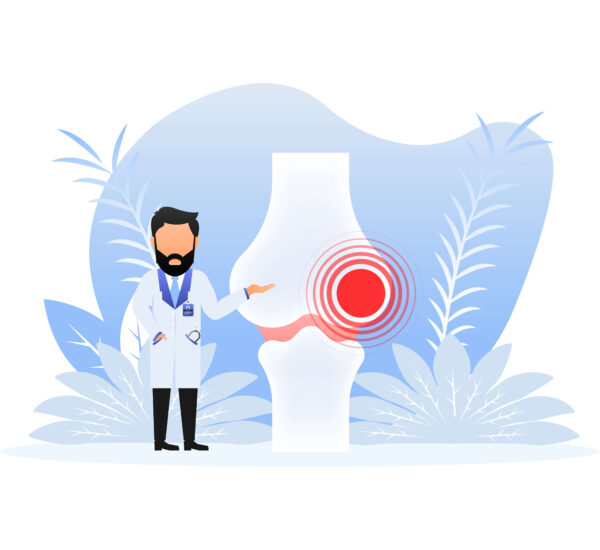Rheumatoid arthritis is a chronic inflammatory condition that primarily affects the joints. It is characterized by pain, swelling, and stiffness in the affected joints, and can significantly impact a person’s quality of life.
Understanding these rheumatoid causes and factors are crucial to effectively manage this complex condition. In this article, we will explore the various causes and factors behind the development of arthritis.
Understanding Rheumatoid Arthritis

Defining Rheumatoid Arthritis
Rheumatoid arthritis is an autoimmune disease, which means that the body’s immune system mistakenly attacks its own tissues. In the case of RA, the immune system primarily targets the synovium, a thin membrane that lines the joints.
This immune response leads to chronic inflammation in the joints, causing damage to the cartilage and surrounding tissues. Over time, this can result in joint deformity and disability.
But what exactly happens during this immune response? When the immune system is functioning properly, it helps protect the body from harmful invaders like bacteria and viruses. However, in the case of rheumatoid arthritis, the rheumatoid causes immune system to go haywire and starts attacking healthy tissues.
The synovium, which is the primary target of this misguided immune response, is responsible for producing synovial fluid. This fluid helps lubricate the joints and reduce friction during movement. When the immune system attacks the synovium, it triggers an inflammatory response.
During inflammation, blood vessels in the affected area widen, allowing immune cells to enter the joint. These immune cells release chemicals that further promote inflammation and attract more immune cells to the site. This creates a vicious cycle of inflammation and tissue damage.
The Impact of Rheumatoid Arthritis on the Body
Rheumatoid arthritis not only affects the joints but can also cause systemic effects throughout the body. The chronic inflammation associated with RA can lead to complications in various organs.
When inflammation occurs in the heart, it can cause pericarditis, which is the inflammation of the sac surrounding the heart. This can lead to chest pain, shortness of breath, and an increased risk of heart attack. Meanwhile, the lung tissues can be affected resulting in coughing, shortness of breath, and chest discomfort.
In terms of the blood vessels, RA can narrow and stiff the passage. It leads to an increased risk of cardiovascular disease. The same the patient’s bones, there can also be a conflict as it can weaken the bones. Thus, the development of osteoporosis and other conditions.
In short, rheumatoid causes systemic effects throughout the body. That’s why, understanding its impact is crucial in providing comprehensive care and support for individuals living with this condition.
Genetics Role in Causing Rheumatoid Arthritis
While the exact cause of RA is still unknown, researchers have made significant progress in understanding the role of genetic factors in the development of this chronic condition. Uncover the relation of genetics in increasing one’s level of risk against this condition.

The Role of Heredity in Rheumatoid Arthritis
There is evidence to suggest a genetic predisposition to the disease. Certain genes, such as the HLA-DRB1 gene, have been found to be associated with an increased risk of developing RA. However, having these genes does not guarantee the development of the condition, as other factors also play a role.
Researchers have discovered that the HLA-DRB1 gene is responsible for encoding a protein that plays a critical role in the immune system. This protein helps the immune system distinguish between the body’s own cells and foreign invaders. However, certain variations of this gene, known as alleles, have been linked to an increased risk of developing RA.
It is important to note that having these genetic variations does not mean that an individual will definitely develop RA. Environmental factors, such as smoking, obesity, and exposure to certain infections, can also contribute to the development of the disease. Additionally, researchers believe that a combination of genetic and environmental factors may be necessary for RA to manifest.
Specific Genes Associated with Rheumatoid Arthritis
In addition to the HLA-DRB1 gene, several other genes have been identified that contribute to the development of RA. These genes affect various aspects of the immune system, including the production of antibodies and the regulation of inflammation.
One such gene is the PTPN22 gene, which is involved in regulating the activity of immune cells. Variations in this gene have been associated with an increased risk of developing RA. Another gene, called STAT4, is involved in the signaling pathways that regulate the immune response. Variations in this gene have also been linked to an increased susceptibility to RA.
Understanding these specific genes and their interactions is vital for ongoing research and may lead to new targeted therapies in the future. By identifying the genetic factors that contribute to the development of RA, researchers can gain insights into the underlying mechanisms of the disease and potentially develop more effective treatments.
Furthermore, studying the genetic factors in RA can also help in identifying individuals who may be at a higher risk of developing the disease. This knowledge can enable healthcare providers to implement preventive measures and offer personalized treatment plans to those who are genetically predisposed to RA.
Environmental Triggers for Rheumatoid Arthritis

Smoking and Rheumatoid Arthritis
Smoking has been identified as a significant environmental risk factor for the development of Rheumatoid Arthritis (RA). Studies have shown that smokers are more likely to develop RA and experience more severe symptoms compared to non-smokers.
When a person smokes, they inhale harmful substances such as nicotine and carbon monoxide. These substances can trigger an abnormal immune response in the body, leading to inflammation in the joints. The inflammation caused by smoking can damage the synovium, which is the lining of the joints, and eventually lead to the development of RA.
Additionally, smoking can also affect the effectiveness of RA treatments. Research has shown that smokers may have a poorer response to certain medications used to manage RA symptoms, such as disease-modifying antirheumatic drugs (DMARDs). This further emphasizes the importance of quitting smoking for individuals with RA.
It is important to note that quitting smoking can have significant benefits for those already diagnosed with RA. Studies have shown that quitting smoking can lead to a reduction in disease activity and improved outcomes for individuals with RA. By quitting smoking, individuals can decrease the inflammation in their joints and potentially slow down the progression of the disease.
Infections and Rheumatoid Arthritis
Infections, particularly certain bacterial and viral infections, have also been implicated as potential triggers for rheumatoid arthritis. It is thought that these infections can activate the immune system, leading to an autoimmune response in susceptible individuals.
When the body is exposed to certain infections, the immune system produces antibodies to fight off the invading pathogens. However, in some individuals, this immune response can become dysregulated, leading to the development of rheumatoid arthritis. The immune system mistakenly attacks the body’s own tissues, including the joints, causing inflammation and damage.
It is important to note that not everyone who experiences an infection will develop RA. The development of RA is a complex process that involves a combination of genetic and environmental factors. While infections may play a role in triggering the disease in some individuals, further research is needed to fully understand the mechanisms behind this relationship.
Understanding the role of infections in the development and progression of RA is crucial for improving prevention and treatment strategies. By identifying individuals who are at a higher risk of developing RA after an infection, healthcare professionals can intervene early and potentially prevent or delay the onset of the disease.
Furthermore, researchers are studying the potential use of vaccines to prevent RA. Vaccines that target specific infections associated with RA may help reduce the risk of developing the disease in susceptible individuals.
In conclusion, smoking and infections are two environmental triggers that have been linked to the development and progression of Rheumatoid Arthritis. Quitting smoking and taking preventive measures against infections can help reduce the risk of developing RA and improve the outcomes for individuals already diagnosed with the disease. Ongoing research is necessary to further understand the complex interplay between environmental factors and RA, ultimately leading to better prevention and treatment strategies.
Hormonal Influences on Rheumatoid Arthritis
The Connection Between Hormones and Rheumatoid Arthritis
Hormonal factors, particularly those related to women’s reproductive health, have long been suspected to play a role in the development of RA. Women are more likely to develop RA compared to men, and there is evidence to suggest that hormonal changes, such as those that occur during pregnancy and menopause, can influence disease activity.
Estrogen, in particular, has been studied extensively for its potential impact on RA. It is thought to have both protective and pro-inflammatory effects on the immune system, although the exact mechanisms are still being explored.
Pregnancy and Rheumatoid Arthritis
Pregnancy can have a variable impact on RA symptoms. Some women experience a temporary improvement in symptoms during pregnancy, while others may experience a flare-up. It is important for women with RA to work closely with their healthcare providers to manage their condition and optimize their chances of a healthy pregnancy.
Lifestyle Factors and Rheumatoid Arthritis
Diet and Rheumatoid Arthritis
While there is no specific diet that has been proven to cure or prevent RA, certain dietary factors may influence disease activity. Omega-3 fatty acids, found in fatty fish and flaxseeds, have been shown to have anti-inflammatory properties and may help reduce joint pain and swelling.
Additionally, maintaining a healthy weight can help alleviate stress on the joints and improve overall well-being. A balanced diet rich in fruits, vegetables, and whole grains can support overall health and may have positive effects on RA symptoms.
Stress and Rheumatoid Arthritis
Although stress alone does not cause RA, it can worsen symptoms and trigger flares. High stress levels can contribute to increased inflammation and make it more difficult to manage the condition effectively.
It is important for individuals with RA to prioritize stress management techniques, such as exercise, meditation, and relaxation techniques, to reduce the impact of stress on their physical and mental well-being.
Conclusion
In conclusion, the development of rheumatoid arthritis involves a complex interplay between genetic, environmental, and hormonal factors. By exploring the causes and factors behind the development of arthritis, it can help patients to understand their condition better.
If you suspect to be a possible patient of rheumatoid arthritis, it would be best to start early prevention. Visit a healthcare provider to begin the diagnosis and treatment for this debilitating condition. Book a consultation online for immediate prevention step!



